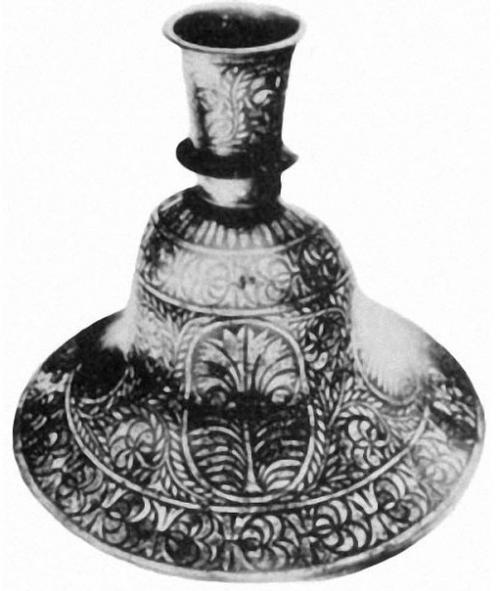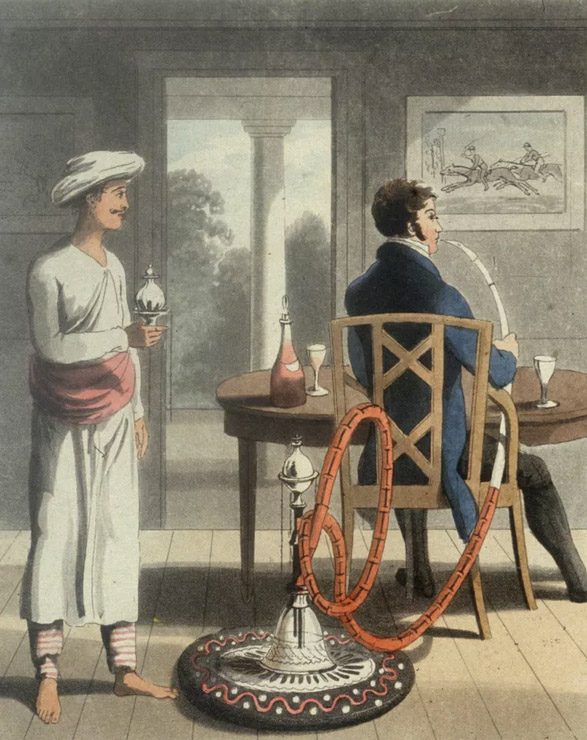1852, May 19: The Dorchester Pot
The June 5, 1852, edition of the Scientific American reprinted an article from the newspaper called the Boston Transcript entitled "A Relic of a By-Gone Age," and which described a puzzling find. "A few days ago," started the article, a powerful blast was made in the rock at Meeting House Hill in Dorchester, Massachusetts, USA, which dislodged a huge amount of rock; some of the pieces knocked free weighed several tons. There was a lot of smaller debris as well... and two pieces of a metallic object.
The pieces, when fitted together, created a bell shaped vessel 4-1/2 inches high, with a 6-1/2 inch base and a 2-1/2 inch top, and was about an eighth of an inch in thickness all around. The color of the vessel's body resembled a composition metal like zinc. On the sides of the object were six figures of a flower, inlaid with pure silver, with a design of a vine or wreath inlaid with silver around the base.
 The Dorchester Pot, according to author Brad Steiger. [Larger version here]
The Dorchester Pot, according to author Brad Steiger. [Larger version here]
The vessel had been encased in the solid 'pudding stone' at a depth of fifteen feet below the surface, and the article stated "there is no doubt but that this curiosity was blown out of the rock ... The matter is worthy of investigation, as there is no deception in this case." The article also states that a Dr. J.V.C. Smith, who had recently traveled in the 'East' and who had "examined hundreds of curious domestic utensils," had never seen anything like the vessel.
A Busy History
Though the quotes above don't show it, the Scientific American article was very dismissive of the event reported, joking that the vessel may have been made by a fictional first inhabitant of Dorchester. The whole matter would likely have been forgotten except that in 1919, sixty-seven years after the Scientific American article was published, Charles Fort revived the account. 1919 is the year that Fort published The Book of the Damned, the first of four books collecting reports of a variety of events that Fort asserted defied common scientific explanation. All of Fort's books went on to become famous in the field of anomalous studies, and many -- MANY -- authors that came after Fort repeated his accounts. Here's how Fort presented the Dorchester story from the Scientific American:
"There's a wretch of an ultra-frowsy thing in the Scientific American, 7-298, which we condemn ourselves, if somewhere, because of the oneness of allness, the damned must also be damning. It's a newspaper story: that about the first of June, 1851, a powerful blast, near Dorchester, Mass., cast out from a bed of solid rock a bell-shaped vessel of an unknown metal: floral designs inlaid with silver; 'art of some cunning workman.' "
While this short mention was not very impressive, the context in which Fort presented the story proved popular... he claimed it was just one of a number of archaelogical finds in rock and other materials which collectively implied the existence of humans at a time in the past which scientists stated that humans should not exist. Fort's reference clue of "7-298" quickly led to other authors pinpointing a copy of the Scientific American's article -- in Vol. 7, on page 298 -- but most of these new authors continued to repeat Fort's mistaken year of 1851 for the event, instead of 1852, implying they didn't actually go read the article themselves. Many of these later authors have also added age estimates for the object, based on the rock layer it was found in, which is stated to be between 570 and 593 million years old!
Some Missing Details
"There is no doubt but that this curiosity was blown out of the rock ... The matter is worthy of investigation, as there is no deception in this case." Those are some very impressive quotes: however, they are not made by the Editors of Scientific American. The article, remember, was reprinted from the Boston Transcript, a newspaper from Boston, Massachusetts; so all quotes above come from their editors, which is slightly less impressive. Strangely, the Scientific American failed to state what date the article was run in the Boston Transcript, so locating and confirming the original is something I didn't believe anyone had bothered trying yet until I dug further on this matter and found an excellent study done on a French website by a user called 'Nali', which included the original Boston Transcript article.
The article was printed in the Boston Transcript of Wednesday, May 26, 1852, and starts "On thursday last;" so the date for the event can now be set as May 19, 1852. The details given in the account above are all in this earlier version of the account, but there are additional details that the Scientific American didn't re-print. The vessel is still described as a bell-shaped object with the dimensions given above, but in addition we find that "In the top there is a hole for a handle, and in the bottom opposite a larger hole is filled with lead, soldered up close. The inside is considerably corroded, but the outside is smooth and free from rust." We are also told "the chasing, carving and inlaying are exquisitely done by the art of some cunning workman, and when new must have been very beautiful." Last, the article states that nearly three-hundred people had seen the object, "many of whom were scientific men."
A Questionable Addition
The account was next revived in 1978 by Brad Steiger in his book Worlds Before Our Own, which is when -- around 125 years after the event was first reported -- the photo of the object above was first associated with the Dorchester story. Steiger wrote that he had received a communication from a man claiming to be the current owner of the strange artifact, named Milton R. Swanson, who stated the vessel had been given to Harvard College after its discovery and then soon forgotten. A building supervisor had eventually brought the object home, and then later sold it to Swanson just before said supervisor died (we are told he was in his eighties). The object, Steiger was told, had been run through a battery of tests for two years by the Museum of Fine Arts in Boston, but no one was able to determine how old it was or what it was meant for.
While intriguing, it's likely that Swanson's story -- and possibly Swanson himself -- is pure fabrication. This is for a very simple reason: the object in the picture has, in fact, been identified. Nali's study of the matter, which I mentioned earlier, displays several pictures of similar objects, which allowed them to not only identify the object in the picture above, but offer a plausible reason why it was associated with the Dorchester story.

Man smoking from a Hookah [Larger version here]
In the photo above, we see a typical English visitor to India having a smoke from an object that looks suspiciously like Steiger's picture of the "Dorchester Pot." This object is a 'hookah' or water-pipe. This illustration appeared in abook published in 1813... so the object that Steiger claims is the mystery Dorchester object is the base of such a water-pipe.
Hookahs had become a big thing in England in 1851 when a Great Exhibtion was held in London which featured, among other things, products from the Royal colony of India -- including hookahs. Nali was able to find a hookah base with extremely similar designs to the object in the Steiger photo that is in the current holdings of the Victoria and Albert Museum, in London, England. In addition, the Steiger photo shows a flower pattern with only four featured flowers, when the Dorchester object was said to display six... so the Steiger photo simply isn't the object that was found in Dorchester after the explosion.
However, all of this evidence points up the fact that the description given of the Dorchester object in the original Boston Transcript article of 1852 does seem to be a good description of a then-current hookah base. It seems likely that there was some suspicion at the time; else why mention specifically that Dr. Smith, identified as a man who had traveled in the 'East' -- then a generic term for anywhere from Japan to India -- had been consulted to try to identify the object?
Given the insistence that "there is no doubt but that this curiosity was blown out of the rock," I have to wonder who stood close enough to the explosion to be sure of that. If, for some reason, the hookah or just the base were on top of the hill above the section that was blown up to create the loose rock, wouldn't it have been found in about the same place?
Anomalies -- the Strange & Unexplained, as well as my other website -- Monsters Here & There -- are supported by patrons, people like you! All new Anomalies articles are now posted for my patrons only, along with exclusive content made just for them. You can become a patron for just $1 a month!
|








